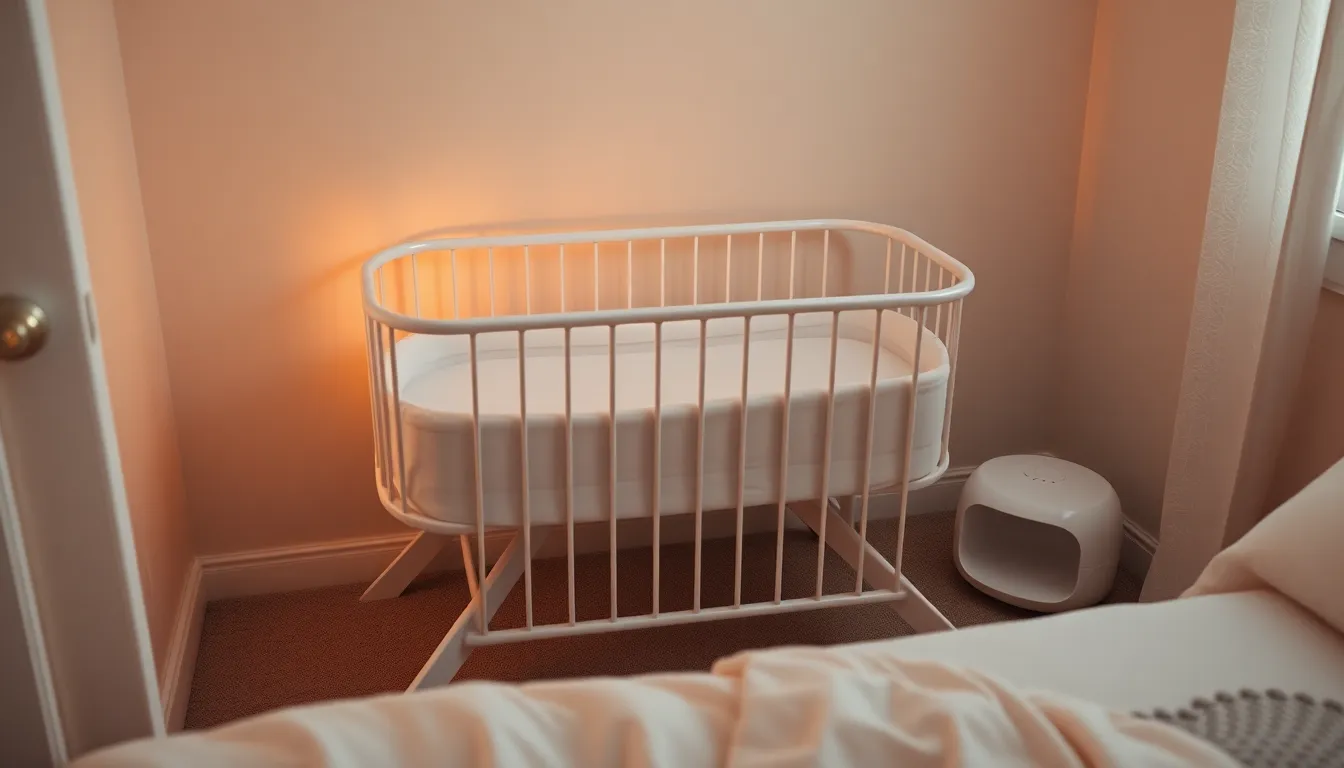Getting a baby to sleep in a bassinet can feel like a high-stakes game of hide and seek. Just when you think you’ve mastered the art of soothing, that tiny human decides it’s time for a midnight dance party. But fear not! With a few clever tips, you can transform your little one’s bassinet into the ultimate snooze zone.
Table of Contents
ToggleUnderstanding Baby Sleep Patterns
Understanding baby sleep patterns plays a crucial role in establishing a successful sleep routine. Infants, especially newborns, spend around 16 to 18 hours sleeping each day, but their sleep is distributed in short intervals. Recognizing these patterns helps parents adapt to their baby’s needs.
The Importance of Sleep for Infants
Sleep significantly affects an infant’s development. Quality rest promotes brain development, supports emotional well-being, and aids physical growth. Babies experience rapid growth during sleep stages, particularly during REM sleep, which enhances cognitive function. Prioritizing sleep for babies can lead to healthier overall outcomes and improved mood regulation.
Common Sleep Challenges
Many factors contribute to sleep challenges for infants. Often, discomfort arises from hunger, diaper changes, or illness. Environmental factors, such as noise or temperature, also disrupt sleep. Additionally, the transition from crib to bassinet can generate anxiety for some babies. Understanding these elements can help parents anticipate issues and create a more restful sleep environment for their little ones.
Preparing the Bassinet

Creating the right environment for a baby in a bassinet enhances their sleep quality. Focus on two main aspects: location and safety.
Choosing the Right Location
Select a peaceful spot for the bassinet. Placing it in a quiet bedroom reduces disturbances from household activities. Ensure it remains close enough for parents to attend to the baby easily. Favor locations with soft lighting to encourage a calming atmosphere. Avoid areas near windows where outside noise can disrupt sleep. Consider positioning near a white noise machine or soft music source to mask potential disruptions.
Ensuring Safety and Comfort
Use a firm, flat mattress in the bassinet to provide adequate support. Fitting a snugly sized sheet ensures safety and reduces the risk of suffocation. Keep the sleeping area free from toys and loose bedding. Maintaining room temperature between 68°F and 72°F helps keep the baby comfortable. Dress infants in light layers to prevent overheating. Regularly check the bassinet’s condition for any wear or loose parts; maintaining safety enhances peace of mind during sleep time.
Establishing a Sleep Routine
Establishing a consistent sleep routine helps babies adapt to the bassinet more easily. Routine offers comfort and predictability, enabling a smoother transition to sleep.
Creating a Calming Environment
Creating a calming environment enhances sleep quality for infants. Soft, dim lighting in the nursery sets a soothing mood. Gentle sounds, like white noise or lullabies, can mask disruptive noises, providing a tranquil backdrop. Keeping the room’s temperature between 68°F and 72°F ensures a comfortable atmosphere. Parents should also choose calming colors for the nursery, as these colors can promote relaxation. A clean, organized space promotes peace, allowing babies to settle down with ease.
Timing and Consistency
Timing and consistency play vital roles in sleep routines. Scheduling naps and bedtime around the same time every day establishes a sense of rhythm. Schedules help babies recognize sleep cues, making it easier for them to fall asleep. Observing your baby’s natural sleep-wake patterns offers insights into optimal sleep windows. Adjusting feeding and playtime around these times aids in this process. Parents should commit to the routine, even on weekends, to maintain the sleep pattern. Consistency reinforces the idea that it’s time for sleep, making the bassinet a familiar place for rest.
Techniques for Encouraging Sleep
Creating effective techniques for encouraging sleep helps babies adjust to their bassinet comfortably. Implementing proper methods can significantly improve sleep quality.
Swaddling Techniques
Swaddling offers a sense of security, mimicking the warmth of the womb. Parents can use lightweight, breathable fabrics to wrap the baby snugly, yet not too tightly around the arms and legs. Ensuring ample room for leg movement is crucial for comfort. It’s recommended to check the baby’s temperature to prevent overheating, as maintaining a comfortable body temperature promotes better sleep. Swaddling can help soothe startle reflexes that often wake infants, enhancing their ability to fall asleep. Regularly practicing this technique creates a calming sensation that aids in settling the baby into the bassinet.
White Noise Usage
White noise provides a soothing backdrop that masks sudden sounds. Consider using a white noise machine or a smartphone app that generates calming sounds, such as ocean waves or gentle rain. Opt for a consistent volume that’s not overpowering, as moderate levels are most effective. Creating a familiar auditory environment helps babies feel secure and encourages deeper sleep. Additionally, turning on white noise during nap and bedtime reinforces sleep routines by signaling to the baby that it’s time to rest. Establishing this practice as part of the sleep environment can foster a tranquil setting for better sleep in the bassinet.
Additional Tips and Tricks
Explore additional strategies to help babies settle into their bassinets more effectively. These methods can create a calming environment that encourages better sleep.
Managing Wakefulness
Monitor your baby’s wakefulness closely to establish healthy sleeping habits. Recognize signs like yawning, rubbing eyes, or becoming fussy as cues that it’s time for sleep. Implement a calming routine to ease the transition from wakefulness to sleep; activities like gentle rocking or singing lullabies work well. Try to avoid overly stimulating interactions right before bedtime, as they can lead to increased alertness. Creating a consistent timeline for naps also helps regulate sleep patterns, making it easier for babies to drift off when placed in the bassinet.
Transitioning from Crib to Bassinet
Facilitate the transition from crib to bassinet by gradually acclimating your baby to the new sleeping space. Start by placing the bassinet in the baby’s room during daytime naps, allowing them to explore it. Leave familiar items nearby, like a favorite blanket or stuffed animal, to create a sense of security. Ensure the bassinet mimics the crib’s environment in terms of comfort and ambiance. Transitioning during a time of low stress may help as well, such as after a feed or during a relaxed moment. Establishing this familiarity helps babies associate the bassinet with safety and calmness.
Getting a baby to sleep in a bassinet can be challenging but it’s achievable with the right approach. By creating a calming environment and establishing a consistent sleep routine, parents can help their infants feel secure and comfortable. Understanding sleep patterns and recognizing cues is essential in fostering a restful atmosphere.
Incorporating techniques like swaddling and white noise can further enhance sleep quality. As parents gradually transition their little ones from crib to bassinet, using familiar items can ease anxiety. With patience and dedication, parents can turn the bassinet into a peaceful haven for their babies, ensuring they get the restful sleep they need for healthy development.



